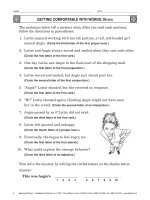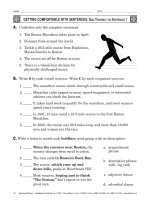Tài liệu Beginning writing 2 part 9 ppt
Bạn đang xem bản rút gọn của tài liệu. Xem và tải ngay bản đầy đủ của tài liệu tại đây (136.87 KB, 10 trang )
68
Beginning Writing 2
• Saddleback Publishing, Inc. © 2001 • Three Watson, Irvine, CA 92618 • Phone: (888) 735-2225 • Fax: (888) 734-4010 • www.sdlback.com
NAME DATE
WRITING A REPORT: P
ARAPHRASING
Unless you are using a direct quotation, avoid copying research information
from sources “word for word.” Restate, or paraphrase, the information. When
you are paraphrasing, pick out the main points and restate them more briefly
in your own words.
A.
Read the encyclopedia sentence about a common garden pest. Underline key
words and phrases you would include if you paraphrased the information.
APHID
(Ay
´
Fihd) is a tiny, soft-bodied insect that sucks the juices of plants,
often severely damaging gardens, orchards, and farm crops.
B.
On the following lines, paraphrase the sentence about aphids.
_______________________________________________________________________
_______________________________________________________________________
_______________________________________________________________________
C.
The following sentences are written in overly formal language.
Paraphrase each item, restating it in simple everyday language.
The first one has been done for you.
1. We employed the services of a youthful engineer to take charge of our
landscaping necessities.
____________________________________________________________________
2. Please deposit your refuse in the circular object meant for receiving
the miscellaneous accumulation of paper materials remaining after
a day of academic pursuit.
____________________________________________________________________
____________________________________________________________________
____________________________________________________________________
3. Those who have the authority to make such requests have asked
that all pursuers of knowledge who attend this institution arrive at
their scheduled meeting-places promptly at the time that has been
previously assigned.
____________________________________________________________________
____________________________________________________________________
____________________________________________________________________
____________________________________________________________________
We hired a boy to mow the lawn and trim the bushes.
Saddleback Publishing, Inc. © 2001 • Three Watson, Irvine, CA 92618 • Phone: (888) 735-2225 • Fax: (888) 734-4010 • www.sdlback.com •
Beginning Writing 2
69
NAME DATE
WRITING A REPORT: Q
UOTING
O
THERS
When using direct quotations from your sources, you must show that the
quotations are not your words. To do this, enclose the passage in quotation
marks and give credit to the source.
A.
Underline each direct quote with one line. Circle the name of the source.
1. In Albert Einstein: Immigrant Genius, author Marci Raymond
describes Einstein as declaring, “It was as if a storm had broken
loose inside my head!”
2. The word April comes from a Latin word meaning “to open.”
According to the Encyclopedia of Natural Science, “The name well
describes the month when the buds are bursting and the whole
season of warmth and sunshine seems to be opening at last.”
3. Hawaii is a surfer’s paradise. In his novel The Cruise of the Snark,
Jack London described the waves of Waikiki Beach by writing the
following: “Why they are a mile long, these bull-mouthed monsters!
They weigh a thousand tons, and they charge into shore.”
B.
Suppose you are writing a report on the anaconda. As a source, you
might use the following article from Our World Encyclopedia. On the
back of this sheet, write one or two sentences that could appear in your
report. Include a direct quote from the encyclopedia article, and give
credit to the source. Use the items in Part A as models.
ANACONDA,
an ah KON dah,
is the
name of large snakes found in
tropical South America. Some
anacondas grow to be more than 30
feet long. Anacondas are often found
swimming in rivers. They kill their
prey by wrapping their coils tightly
around them and thus keeping
them from breathing. Although the
snakes have a fierce appearance
and hunting style, humans have little
to fear from them. Only a colossal
anaconda will attack large mammals.
Humans will be safe if they stay a few
feet away from the reptile.
70
Beginning Writing 2
• Saddleback Publishing, Inc. © 2001 • Three Watson, Irvine, CA 92618 • Phone: (888) 735-2225 • Fax: (888) 734-4010 • www.sdlback.com
NAME DATE
WRITING A REPORT: W
RITING
A
B
IBLIOGRAPHY
A
bibliography
is a list of sources. These include any books, reference books,
or periodicals the writer used to research a topic. Bibliographies list items in
alphabetical order.
Study the sample bibliography. Then underline the words that correctly
complete each sentence below.
Acuna, Luis. The Wildlife of South America. Boston: Worldwide Press, 1999.
“Anaconda.”
Our World Encyclopedia, Vol. 1. New York: Educational Publishing
Company, 2000, pp. 45–46.
Martinez, Sonia. “River Serpents.”
Traveler’s Guide, June 2000, Vol. 15, p. 14.
1. The bibliography entries are listed in ( alphabetical order
/
the order in which the writer used them ).
2. When listing a book, first write ( the name of the book
/
the author’s last name ).
3. When listing an encyclopedia article, first write
( the name of the encyclopedia
/
the entry word ).
4. When listing a periodical article, first write ( the name of the article
/
the last name of the article author ).
5. “River Serpents” is the name of a ( periodical
/
periodical article ).
CHALLENGE:
Mavis wrote a report on penguins. She used the four sources
named below. On the back of this sheet, write a bibliography Mavis could
include at the end of her report. Be sure to alphabetize the entries.
Report Sources:
• World of Knowledge Encyclopedia, volume 14, pages 221–223, published in
1998 by Acme Press, which is in Lincoln, Nebraska.
• Arctic Animals by Mika Draper, published in 2000 by Northern Lights
Publishing Co. of Anchorage, Alaska.
• “The Bird in the Tuxedo,” a magazine article by I. M. Freazin, published in
Science Weekly, the January 2000 issue, Volume 15, p. 40.
• Life Science, by Joseph Echo, published in 1999, by School Time Texts, Inc.,
of New York City, New York.
Saddleback Publishing, Inc. © 2001 • Three Watson, Irvine, CA 92618 • Phone: (888) 735-2225 • Fax: (888) 734-4010 • www.sdlback.com •
Beginning Writing 2
71
NAME DATE
WRITING A REPORT: R
ESEARCH
THE
M
YSTERIES
Encyclopedias, dictionaries, and almanacs have information on all
sorts of topics. Sharpen your research skills by finding the answers
to these questions about some world-famous mysteries. Write your
answer and the name of your source.
1. What is the Bermuda Triangle? ____________________________________
____________________________________________________________________
SOURCE:
_____________________________________________________________
2. What is a Sasquatch? ______________________________________________
____________________________________________________________________
SOURCE:
_____________________________________________________________
3. In what country would a monster-hunter
search for the Loch Ness Monster? __________________________________
SOURCE:
_____________________________________________________________
4. Who assisted the fictional detective
Sherlock Holmes in solving cases? __________________________________
SOURCE:
_____________________________________________________________
5. What happened to Amelia Earhart? _________________________________
____________________________________________________________________
SOURCE:
_____________________________________________________________
6. What wicked deed was Lizzie Borden accused of doing? _______________
____________________________________________________________________
SOURCE:
_____________________________________________________________
7. Why do zebras have stripes? _________________________________________
____________________________________________________________________
SOURCE:
_____________________________________________________________
8. What was Atlantis and what is said to have happened to it? ____________
____________________________________________________________________
____________________________________________________________________
SOURCE:
_____________________________________________________________
CHALLENGE:
On the back of this sheet, write an informative paragraph about
one of the topics above.
72
Beginning Writing 2
• Saddleback Publishing, Inc. © 2001 • Three Watson, Irvine, CA 92618 • Phone: (888) 735-2225 • Fax: (888) 734-4010 • www.sdlback.com
NAME DATE
WRITING A REPORT: T
EST
Y
OUR
R
EPORT
-W
RITING
S
KILLS
A.
Circle the hidden words where they
appear in the puzzle. The words may
go up, down, across, backward, or
diagonally. Check off each word as
you find it.
__ CONCLUSION __ OUTLINE __ NOTES
__ ENCYCLOPEDIA __ REPORT __ TOPIC
__ PERIODICAL __ CATALOG __ BODY
__ BIBLIOGRAPHY __ SUBJECT __ TITLE
__ INTRODUCTION __ AUTHOR __ QUOTE
__ PARAPHRASE __ ALMANAC
B.
Use the hidden words from Part A to complete the sentences below.
Notice that the first letter of each word is given as a hint.
1. The three main parts of a report are the
i
____________________, the
b
____________________, and the
c
____________________.
2. To restate information in one’s own words is to
p
____________________.
3. When a writer copies a portion of text into a report, this is a direct
q
____________________.
4. To find out if your library has a book on a certain subject, you would
look in the library
c
____________________.
5. Books in the library can be located according to
s
____________________,
t
____________________, or
a
____________________.
6. To find information on almost any topic, an
e
____________________ is a
good place to begin research.
7. An
a
____________________ is a book of facts, statistics, and records on
many subjects.
8. A
p
____________________ is a publication, such as a magazine or
newspaper, that comes out on a regular basis.
9. Before writing a report, writers often organize their ideas in an
o
____________________.
10. A
b
____________________ at the end of a report lists a writer’s sources.
EPARAPHRASEZN
NTREPORTOMBAO
CONCL US I ONCKT
YASOSUBJECTAE
C ET OUQ E L T I T U S
LTAAL MANACOTK
OB I BL I OGRAPHY
PXRBTOAMOC I OD
EWODL FGNPVCRO
DPER I OD I CALWB
I NTRODUCT I ONY
AOUTL I NEZCUFL









